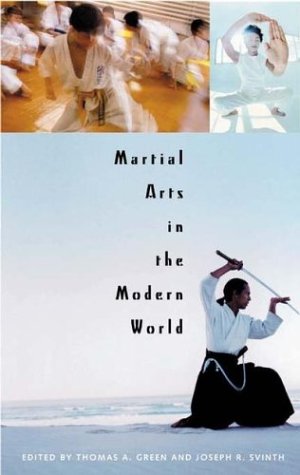
Edited by Thomas A. Green & Joseph R. Svinth
ISBN: 0-275-98153-3
By Ron Mottern
Copyright © Ron Mottern 2004. All rights reserved.
The publisher’s review of this text does not even come close to capturing the spirit of the essays contained in Martial Arts in the Modern World. Editors, Thomas A. Green and Joseph R. Svinth, have written and collected a veritable treasure trove of material that examines popular, and some not so popular, martial arts from a fresh perspective. The book’s dedication, to John F. Gilbey, serves as a good preface to what one can expect from the work.
As Dr. Green states in the introduction, this is not an instructional book but one that examines “the forces and philosophies that shaped the fighting arts of the twentieth century.” His opening essay on “Sense in Nonsense” looks at the functional role of folk history within martial systems and sets the framework for a more critical analysis of present day martial systems. The papers presented take a look at the role of civil combative systems within the modern world, from the ubiquitous judo, kendo and karate to the less well-known capoeira to the more obscure arts of Indian wrestling, kalenda and “knocking and kicking,” and how they have influenced the contemporary martial mundi. This is not to say that the tone of the text is dryly academic. Indeed, the essays are easily digested and thoroughly good reading.
The origins of Gracie Jiu-Jitsu in classical judo cum professional wrestling, via Maeda Mitsuyo, are examined in “The Circle and the Octagon.” The origins of Taekwon Do from classical Japanese karate are presented in a paper by Eric Madis. Joe Svinth looks at boxing in Imperial Japan in “The Spirit of Manliness.” An article on “The Little Dragon: Bruce Lee” is not the idol worshipping prune whip that one would expect from a piece with that title. Instead, it is a thoughtful essay on the humanness of the man that has become an icon in popular martial culture. Yamada Shoji’s piece on “The Myth of Zen in the Art of Archery” debunks the paradigm of mysticism that has surrounded Japanese archery in the West. (This is a good companion piece to William Bodiford’s entry on “Religion and Spiritual Development: Japan” in Dr. Green’s, Martial Arts of the World: An Encyclopedia. Bodiford, among other things, looks at how Suzuki did to kendo what Herrigel did to kyudo, that is, create a nationalistic mystique around a utilitarian technique.) Dr. Green’s articles on “Surviving the Middle Passage: Traditional African Martial Arts in the America” and “Freeing the Afrikan Mind: The Role of Martial Arts in Contemporary African American Cultural Nationalism” are a glimpse into a heretofore unexplored martial cultural heritage within the African American community.
Also included in the text is a paper on the great Indian wrestler Gama, “Lion of the Punjab,” by Graham Noble, and his introduction of the art of Indian wrestling to England in 1910. “The Martial Arts in Chinese Physical Culture, 1865-1965” is examined by Stanley E. Henning. Jennifer Hargreaves takes a serious look at the history of women’s boxing, from eighteenth and nineteenth century prizefighting to boxerobics. Tony Wolf relates his philosophy of performance combat, as applied to his work in The Lord of the Rings trilogy, in “Action Design: New Directions in Fight Choreography.” The development of “Kendo in North America, 1885-1955” is discussed by Joe Svinth. And Richard Bowen looks at the “Origins of the British Judo Association, the Judo Union, and the International Judo Federation,” with an emphasis on his perception of how the philosophy of the organization changed with its titles. Perhaps the most confusing article in the text is “Martial Arts Meet the New Age: Combatives in the Early Twenty-first-Century American Military.” The text, itself, isn’t confusing. Svinth does his usual superlative treatment of the subject. But even with Svinth’s writing to try and explain it, the adoption of Gracie Jiu-Jitsu by the U.S. Army for combative training remains mind-boggling.
Definitely check it out!